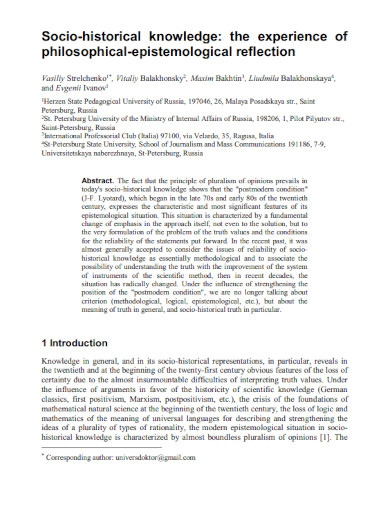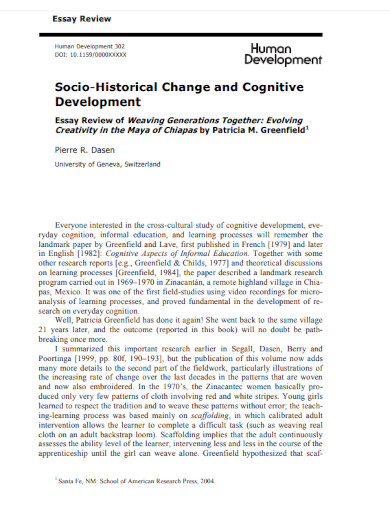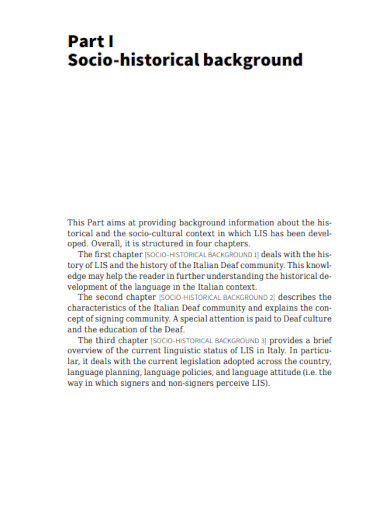Socio-Historical Examples to Download
History has a lot of facets, elements, and characteristics that are heavily intertwined with the richness of all the cultures surrounding it. Social history is a type of history that delves into the historical social roots of a specific country, ethnicity, race, or ethnic group. This type of history recounts the state of the society and the various highs and lows of said societies.
1. Socio-historical Knowledge Template
2. Socio-Historical Change and Cognitive Development
3. A socio-historical Approach to Policy Analysis
4. Socio-historical Background Template
What Is Socio-Historical Context?
A socio-historical context is a specific context that tries to indicate the various chronological social and historical characteristics that will pertain to a specific period. Not only that but the socio-historical context will also consider various themes and tones that will be present in the past but is not present in modern society.
How to Identify the Socio-Historical Context of A Specific Period
Every object, entity, event, and work have various socio-historical context that will provide various insights and interpretations. When examining or appreciating historical or dated objects, entities, events, and works it is important to know how to identify these specific socio-historical contexts to further one’s appreciation and understanding of said thing’s objective and importance.
Step 1: Determine the Time and Place of the Material
Begin by determining the time and place of the origin of the material you are trying to examine. This will not only provide insight into the age of the material but will also help indicate the various materials, state, makeup, and appearance of the material.
Step 2: Identify the Main Usage or Subject of the Material
The next step you should take is to identify the main usage or subject the material tries to encompass, explain, or make. Not only will the usage or subject matter of the material provide further understanding, but it will also ensure one will understands the material’s importance.
Step 3: Determine the Major Themes that Surround the Material
If the material you are examining is an art piece, a book, or a poem, you must determine the various major themes that the artist has incorporated into their material. The themes the material can present may not exist in modern times, which will allow you to gain additional insight into the subject matter the material presents.
Step 4: Check on the Background of the Creator or Person Who Made the Material
Another concept you will need to consider is the background of the person or people who have created the material you are investigating. You must check the social status, group affiliation, and status of the person or people, to further your understanding of the nature of the material and its use.
FAQs
Why is it important to understand the socio-historical context before truly examining a historical piece?
A lot of contexts, social situations, themes, and issues are not present in modern times due to various advancements in technology and techniques. This means that current points of view and outlooks will not truly grasp and comprehend the value or importance of a historical piece unless they will consider the socio-historical context of the thing they are examining.
Is it important to know the social-historical context of an event, action, or art piece before criticism?
Yes, it is very important to understand and know the social-historical context that surrounds an event, action, or art piece before you criticize them. This is because some of the thematic explorations, tones, and thinking may not be present in the current circumstances, which will lead to dissonances in thinking.
How can a social-historical context change a person’s way of thinking?
As life goes on people’s ideals, goals, and objectives change as various social things impact the life of the person. For example, if a person faces a large crisis in their life, it may significantly change the way they or will think or perceive the world. This may also result in trauma if the impact has a negative connotation on the well-being of the person.
Social-historical contexts are elements that surround an object, event, entity, or piece’s historical and social background, context, and beliefs that are prevalent at a specific period. It is very important to know and understand the social-historical context that surrounds a specific thing, as it can deepen our empathy, understanding, and appreciation of the specified thing.
Socio-Historical Examples to Download

History has a lot of facets, elements, and characteristics that are heavily intertwined with the richness of all the cultures surrounding it. Social history is a type of history that delves into the historical social roots of a specific country, ethnicity, race, or ethnic group. This type of history recounts the state of the society and the various highs and lows of said societies.
1. Socio-historical Knowledge Template

e3s-conferences.org
Details
File Format
PDF
Size: 82 KB
2. Socio-Historical Change and Cognitive Development

unige.ch
Details
File Format
PDF
Size: 80 KB
3. A socio-historical Approach to Policy Analysis

scielo.br
Details
File Format
PDF
Size: 54 KB
4. Socio-historical Background Template

edizionicafoscari.unive.it
Details
File Format
PDF
Size: 46 KB
What Is Socio-Historical Context?
A socio-historical context is a specific context that tries to indicate the various chronological social and historical characteristics that will pertain to a specific period. Not only that but the socio-historical context will also consider various themes and tones that will be present in the past but is not present in modern society.
How to Identify the Socio-Historical Context of A Specific Period
Every object, entity, event, and work have various socio-historical context that will provide various insights and interpretations. When examining or appreciating historical or dated objects, entities, events, and works it is important to know how to identify these specific socio-historical contexts to further one’s appreciation and understanding of said thing’s objective and importance.
Step 1: Determine the Time and Place of the Material
Begin by determining the time and place of the origin of the material you are trying to examine. This will not only provide insight into the age of the material but will also help indicate the various materials, state, makeup, and appearance of the material.
Step 2: Identify the Main Usage or Subject of the Material
The next step you should take is to identify the main usage or subject the material tries to encompass, explain, or make. Not only will the usage or subject matter of the material provide further understanding, but it will also ensure one will understands the material’s importance.
Step 3: Determine the Major Themes that Surround the Material
If the material you are examining is an art piece, a book, or a poem, you must determine the various major themes that the artist has incorporated into their material. The themes the material can present may not exist in modern times, which will allow you to gain additional insight into the subject matter the material presents.
Step 4: Check on the Background of the Creator or Person Who Made the Material
Another concept you will need to consider is the background of the person or people who have created the material you are investigating. You must check the social status, group affiliation, and status of the person or people, to further your understanding of the nature of the material and its use.
FAQs
Why is it important to understand the socio-historical context before truly examining a historical piece?
A lot of contexts, social situations, themes, and issues are not present in modern times due to various advancements in technology and techniques. This means that current points of view and outlooks will not truly grasp and comprehend the value or importance of a historical piece unless they will consider the socio-historical context of the thing they are examining.
Is it important to know the social-historical context of an event, action, or art piece before criticism?
Yes, it is very important to understand and know the social-historical context that surrounds an event, action, or art piece before you criticize them. This is because some of the thematic explorations, tones, and thinking may not be present in the current circumstances, which will lead to dissonances in thinking.
How can a social-historical context change a person’s way of thinking?
As life goes on people’s ideals, goals, and objectives change as various social things impact the life of the person. For example, if a person faces a large crisis in their life, it may significantly change the way they or will think or perceive the world. This may also result in trauma if the impact has a negative connotation on the well-being of the person.
Social-historical contexts are elements that surround an object, event, entity, or piece’s historical and social background, context, and beliefs that are prevalent at a specific period. It is very important to know and understand the social-historical context that surrounds a specific thing, as it can deepen our empathy, understanding, and appreciation of the specified thing.

